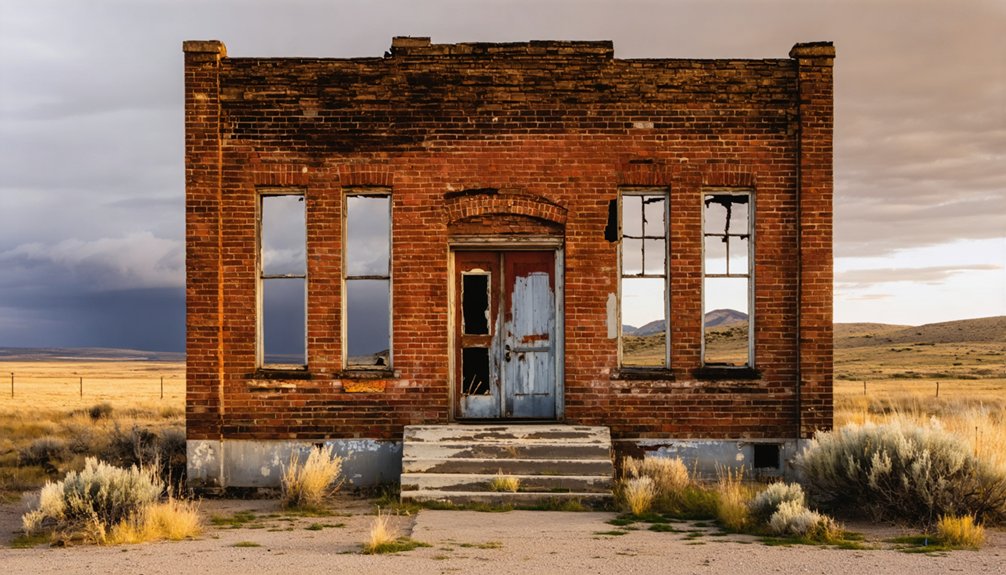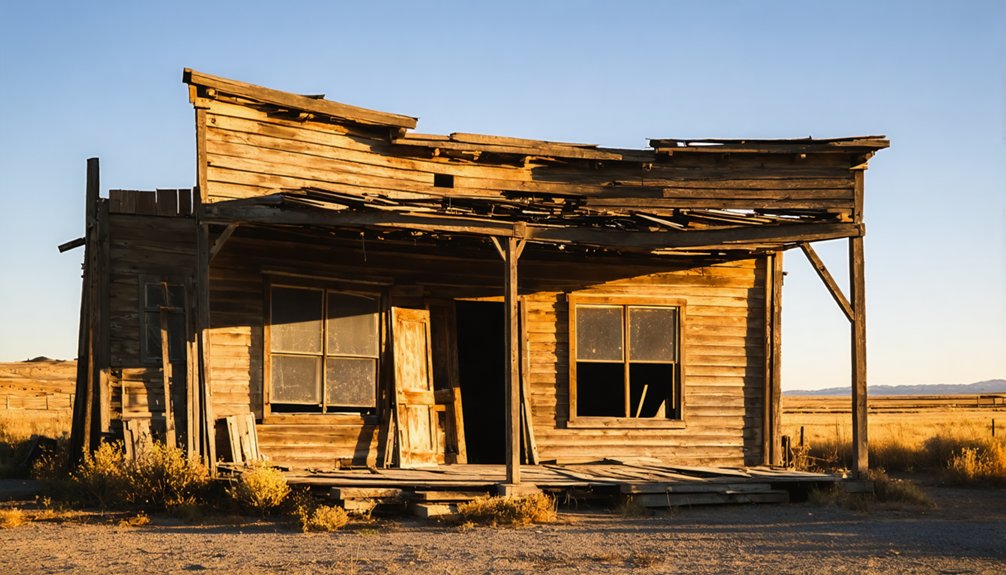You’ll discover Roseberry, Idaho‘s most well-preserved Finnish-American ghost town, nestled 96 miles north of Boise near present-day Donnelly. Established by Finnish immigrants in the late 1800s, this once-thriving community features distinctive dovetail-joined log cabins and traditional saunas. Though the town declined after a 1914 railroad bypassed it, the Long Valley Preservation Society now maintains 22 historic buildings that you can tour from May through September. The story of Roseberry’s Finnish heritage runs deeper than its weathered timbers.
Key Takeaways
- Roseberry was founded by Finnish immigrants in the late 19th century and became Valley County’s largest settlement by 1911.
- The town declined after 1914 when the railroad was built two miles away, causing businesses and residents to relocate to Donnelly.
- Twenty-two historic buildings remain as a museum complex showcasing Finnish-American architecture and cultural heritage.
- The Long Valley Preservation Society maintains the ghost town’s structures and offers seasonal visitor access from May through September.
- Original buildings include the 1905 General Store and 1898 Korvola Cabin, demonstrating traditional Finnish log construction methods.
A Finnish Settlement in Long Valley
As Russian occupation intensified in Finland during the late 19th century, a wave of Finnish immigrants made their way to Long Valley, Idaho, establishing what would become the town of Roseberry.
Located 96 miles north of Boise near present-day Donnelly, this community drew Finns seeking freedom and the promise of available land for homesteading.
Finnish immigrants found a new beginning 96 miles north of Boise, drawn by freedom and the chance to stake their homesteading claims.
Despite the harsh winters and homesteading challenges, Finnish traditions remained strong in their new settlement.
You’ll find evidence of their masterful craftsmanship in the tight-fitting log cabins built with dovetail joints, requiring no chinking between logs.
Their legendary resilience, known as “sisu,” proved essential during brutal winters, particularly the devastating winter of 1888-89.
The sauna, central to Finnish culture, became a cornerstone of both hygiene and social life in this thriving community.
Over 25 historic buildings have been preserved and are now available for visitors to explore from May through September.
Today, Frank and Kathy Eld continue preserving the town’s heritage through restoration projects and the operation of the Roseberry General Store and Museum.
Life Before the Railroad’s Relocation
While the turn of the 20th century saw many frontier towns fade into obscurity, Roseberry flourished as Valley County’s largest settlement by 1911. You’d have found thirty families thriving in this bustling community, with the Cole and Blankenship clans among the first to arrive in 1888. The arrival of Finnish immigrants in the area brought additional cultural diversity to the growing town.
The town’s early economy centered around trading, featuring a vibrant mix of businesses that served the growing population. The community dynamics reflected a tight-knit frontier spirit, anchored by two churches and a complete educational system including both grade school and high school. The region’s lush, fertile grasslands initially drew homesteaders seeking agricultural opportunities.
You would’ve witnessed the town’s prominence firsthand – it was even considered for the county seat. Named after its first postmaster, Louis Roseberry, the town was officially plotted in 1905 and incorporated just two years later.
The Path to Becoming a Ghost Town
The fateful decision to build the Pacific, Idaho and Northern Railroad two miles west of Roseberry in 1914 marked the beginning of the town’s decline.
You’d have witnessed a dramatic transportation shift as businesses and residents moved closer to the new rail line, establishing the town of Donnelly.
The community decline accelerated as Roseberry lost its economic lifeline.
You would’ve seen the hotel, blacksmith shops, restaurant, butcher, and logging mill either shut down or relocate.
The once-thriving Finnish-American community dispersed, leaving behind empty buildings and quiet streets.
Most structures fell into disrepair, while others were physically moved to Donnelly.
The largest creamery in Long Valley was among the businesses that ceased operations.
Today, the town’s heritage lives on through its historic schoolhouse remains, alongside the general store, barn, and carriage house.
Preserving Finnish-American Heritage
Despite Roseberry’s decline as a bustling town, its Finnish-American heritage lives on through dedicated preservation efforts that began in the 1970s.
You’ll find the largest display of Finnish culture in the Western United States here, where Frank Eld’s restoration initiatives have saved numerous historic buildings from decay. The Long Valley Preservation Society, established in 1973, now manages 22 buildings in the museum complex that showcase authentic Finnish log construction techniques. The sense of community continues to inspire youth through organized school visits.
Visitors can explore these historic structures during seasonal operating hours from May through September, with special weekend accessibility.
Cultural preservation extends beyond architecture to living traditions. You can witness Finnish customs like the placement of lanterns on cemetery headstones during Christmas, or attend summer music festivals that bring the community together.
Through heritage tourism, Roseberry’s unique Finnish-American story continues to educate and inspire visitors from around the world.
Architectural Legacy and Building Restoration
Standing as proof of Finnish craftsmanship, Roseberry’s architectural legacy includes over 20 meticulously preserved historic buildings that now form an impressive museum complex.
The historic site continues to serve as the venue for the popular Summer Music Festival each year.
You’ll discover the architectural significance in structures like the 1905 General Store with its western false-front design and the Korvola Cabin’s precise dovetail joints from 1898.
Frank Eld leads the preservation efforts, using his forty years of expertise to maintain these historic treasures.
The restoration techniques honor traditional methods, with each building carefully dismantled, labeled, and rebuilt using period-appropriate materials:
- Hand-crafted wooden nails and authentic tools maintain historical accuracy
- Traditional Finnish log construction features tight-fitting joints without chinking
- Native timber usage reflects both local resources and cultural building practices
- Preservation projects balance modern functionality while protecting heritage features
You can witness this craftsmanship firsthand, from the Johnson Cabin to the Mahala Blacksmith Shop, each telling its own story of frontier ingenuity.
Cultural Traditions That Endure
Since fleeing Russian rule in the late 19th century, Finnish settlers in Roseberry created a rich cultural tapestry that endures today through preserved traditions and community celebrations.
You’ll find their spirit alive in the town’s cherished lantern lighting ceremony, where locals honor their ancestors by placing lights on headstones during Christmas, a custom that’s been lovingly revived.
The cultural exchange between Finnish heritage and Idaho life has shaped a unique community identity that you can experience at the annual Summer Music Festival.
Despite the town’s decline after the railroad bypassed it in 1914, local families maintain strong ties to their Finnish roots through community gatherings and preservation efforts, keeping their ancestors’ legacy vibrant in Long Valley.
Visiting Historic Roseberry Today

You’ll find the Roseberry General Store and museum complex open from May through September, offering Finnish gifts and local historical exhibits.
The site’s special events calendar features the popular Summer Music Festival in July, along with regular educational tours and workshops throughout the season.
To reach historic Roseberry, take Roseberry Road just east of Donnelly, Idaho, about 96 miles north of Boise – with nearby McCall providing additional amenities for your visit.
Museum and Store Hours
While exploring the historic townsite of Roseberry is possible year-round, you’ll want to plan your museum and general store visits carefully around seasonal hours.
Both facilities operate on a limited schedule that changes with the seasons, ensuring you can experience these preserved pieces of Idaho history.
- During peak season (Memorial Day Weekend through Labor Day), visit Friday through Sunday between 1-5 PM
- May and September visits are limited to Sundays from 1-4 PM
- The General Store mirrors the museum hours during summer months
- Research visits to the Nelle Tobias Research Center require advance appointments
You’ll find the museum packed with local history, including early childhood displays and a heroes wall, while the General Store showcases authentic early 20th-century merchandise displays that capture the essence of frontier commerce.
Special Events Calendar
Throughout the year, Roseberry comes alive with a vibrant calendar of special events that showcase Idaho’s rich heritage and local culture.
Among the event highlights, you’ll find the Summer Music Festival from July 17-19, 2025, featuring performances by Jesse Roper and Dustbowl Revival. Local attractions include the Arts and Crafts Fair on July 5-6, where you can browse handmade creations from regional artisans.
Don’t miss Cowboy Trade Days & Antique Fair on June 21-22, celebrating Western heritage with unique finds. The season wraps up with a community Ice Cream Social on August 30.
For history buffs, the Nampa Recreation Department offers guided tours of Roseberry’s historic buildings, giving you an intimate look at this former frontier town’s fascinating past.
Getting to Roseberry
Beyond the scheduled events that draw visitors to this historic settlement, reaching Roseberry itself is a straightforward journey.
You’ll find this Finnish ghost town east of Donnelly, Idaho, with driving routes offering stunning views of Lake Cascade and the surrounding valley. While GPS coordinates aren’t publicly listed, you can easily navigate to the site from either McCall or Donnelly, where you’ll find essential services for your trip.
- Take the scenic route along Lake Cascade for breathtaking mountain vistas
- Plan your arrival before sunrise to capture the best photography conditions
- Drive with seasonal awareness, as road conditions can vary throughout the year
- Use Donnelly or McCall as your base camp, both offering nearby amenities
The roads leading to Roseberry remain accessible year-round, though you’ll want to check current conditions during winter months.
Frequently Asked Questions
Are There Any Reported Ghost Sightings or Paranormal Activity in Roseberry?
You won’t find documented ghost stories or paranormal investigations in this historic site. Despite its “ghost town” status, there’s no evidence of supernatural activity in the restored Finnish settlement.
What Happened to the Original Finnish Families Who First Settled Here?
You’ll find that original Finnish families either moved to nearby Donnelly for railroad access, assimilated into other communities, or passed down their cultural impact through generations preserving their Finnish heritage locally.
Can Visitors Stay Overnight in Any of the Historic Buildings?
You won’t find overnight accommodations in Roseberry’s historic buildings due to preservation restrictions. Instead, you’ll need to choose from nearby modern hotels, vacation rentals, or cozy cabins in the surrounding area.
How Many People Currently Live Within Roseberry’s Original Town Boundaries?
You won’t find current population data for Roseberry’s original boundaries, as it’s now primarily preserved as a historic site rather than an active residential area of town history.
Are There Any Finnish Language Classes or Cultural Workshops Offered?
You won’t find Finnish culture workshops or language immersion classes in the area. Your closest options are online tutoring through Idaho Springs, CO tutors, starting at $9/hour via Skype.
References
- https://test.citylifestyle.com/articles/step-back-in-time
- https://stowawaymag.byu.edu/2010/12/07/roseberry-idahos-little-finland/
- https://finnishnotdone.com/2013/10/10/finnish-idaho-preserved-by-frank-eld/
- https://cascadechamber.com/place-to-visit-historic-roseberry-idaho/
- http://www.historicroseberry.org/pages/TownSite.php
- https://www.ghosttowns.com/states/id/roseberry.html
- https://idaho.for91days.com/an-ice-cream-social-in-historic-roseberry/
- https://www.allmccall.com/history_museums/historic_roseberry_idaho.php
- https://landingaday.wordpress.com/2010/02/28/roseberry-idaho/
- http://appetiteforidaho.blogspot.com/2013/11/roseberry-idaho-restoration-inspiration.html



